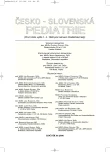-
Medical journals
- Career
Function of Endocrine Glands in Patients with Anorexia Nervosa
Authors: Ľ. Tichá 1; E. Tomečková 2; J. Hornová 1; S. Niňajová 1; J. Birčák 1
Authors‘ workplace: 1. detská klinika Lekárskej fakulty Univerzity Komenského a Detskej fakultnej nemocnice, Bratislava prednostka doc. MUDr. M. Benedeková, PhD., mim. prof. 1; Oddelenie klinickej biochémie Detskej fakultnej nemocnice, Bratislava primárka MUDr. A. Behúlová, PhD. 2
Published in: Čes-slov Pediat 2006; 61 (10): 573-577.
Category: Original Papers
Overview
Background:
Anorexia nervosa (AN) is an eating disorder occurring mostly in adolescent girls. Final outcome of this life-threatening disorder may be affected by endocrine abnormalities due to long-term starvation.Aims:
The authors evaluated the relationship between indexes of body weight and endocrine parameters in adolescent patients with AN.Patients and methods:
In this study the authors investigated indexes of body weight – deficit of weight (%), body mass index SD in 32 girls with AN (age 15.33 ± 0.27) prior to refeeding, and after initiation of refeeding (age 15.70 ± 0.32) as well as in a control group of healthy girls (age 15.71 ± 0.46). They took samples of blood to determine growth hormone (GH), prolactin (PRL), thyrotropic hormone (TSH), triiodothyronine (T3), thyroxine (T4), adrenocorticotropic hormone (ACTH), dehydroepiandrosterone (DHEA), cortisol, 17-OH progesterone, follicle stimulating hormone, luteinizing hormone (LH), estradiol, progesterone, testosterone.Results:
Values of weight (%) were low in girls with AN, but they increased after refeeding, but they were lower than in control group (-28.78 ± 1.37, vs. -12.39 ± 1.70 vs. -4.14 ± 0.46 %, p <0.001). Increased concentrations were found for T3 (1.55 ± 0.05, vs.1.84 ± 0.12 nmol/l, p <0.05), LH (0.55 ± 0.12 U/l vs. 4.5 ± 1.11 U/l, p <0.005, vs. 3.65 ± 0.64, n.s.) and FSH (2.43 ± 0.55 vs. 4.87 ± 0.61 U/l, p <0.001 vs. 4.68 ± 0.41, n.s.) after refeeding, but they were lower than in control group. Decreased concentrations were found for cortisol (675.49 ± 69.03 vs. 505.28 ± 33.4, p <0.05) and progesterone (4.87 ± 0.75 vs. 3.36 ± 0.85, p <0.05) after refeeding.Conclusion:
These results demonstrated several endocrine changes in fasting patients with AN. These include increase frequency of low T3 syndrome, increased stimulation of the hypothalamus – hypophysis – adrenal axis. Low LH, FSH levels and their significant increase after refeeding can be a physiological answer of organism to increments of body weight. Additional studies are needed to evaluate the interaction of these hormonal changes with other endocrine parameters, levels of which are not correlated with the severity of the underlying disorder.Key words:
anorexia nervosa, endocrine abnormalities
Labels
Neonatology Paediatrics General practitioner for children and adolescents
Article was published inCzech-Slovak Pediatrics

2006 Issue 10-
All articles in this issue
- The Practical Significance of Non-cholesterol Sterols during Monitoring of Drug Treatment of Familial Hypercholesterolemia in Children and Adolescents
- Long-term Observation of Functional Structural Changes in Children with Vesicoureteric Reflux
- Function of Endocrine Glands in Patients with Anorexia Nervosa
- Familial Hypomagnesemia with Hypercalciuria and Nephrocalcinosis – Cases and Differential Diagnosis
- The First Case of Glucose Transporter Type 1 (GLUT-1) Deficiency Syndrome in Slovakia
- Tubulization of Transposed Stomach in Atresia of Esophagus
- Experience with the Enzyme Substitution Therapy in Mucopolysaccharidosis
- Diabetic Ketoacidosis
- Therapy of Diabetic Ketoacidosis
- Transplantation of Hematopoietic Cells in Children
- Rational Antibiotic Therapy in Neonatology
- Czech-Slovak Pediatrics
- Journal archive
- Current issue
- Online only
- About the journal
Most read in this issue- Diabetic Ketoacidosis
- The First Case of Glucose Transporter Type 1 (GLUT-1) Deficiency Syndrome in Slovakia
- Therapy of Diabetic Ketoacidosis
- Familial Hypomagnesemia with Hypercalciuria and Nephrocalcinosis – Cases and Differential Diagnosis
Login#ADS_BOTTOM_SCRIPTS#Forgotten passwordEnter the email address that you registered with. We will send you instructions on how to set a new password.
- Career

